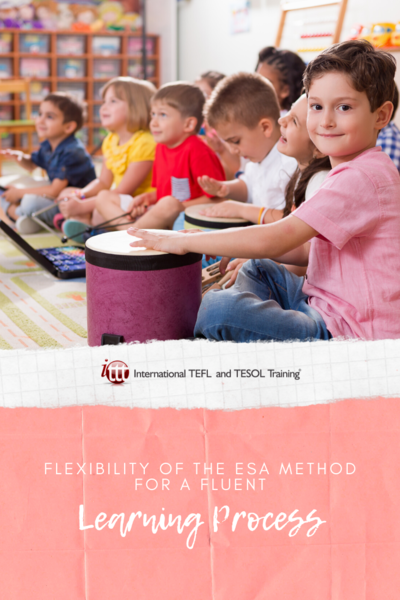Flexibility of the ESA Method For a Fluent Learning Process

"Engage-Study-Activate" also known as ESA - is an effective teaching model designed by Jeremy Harmer. This methodology means, that for the best involvement of students in a learning process, the conditions of the lesson should be flexible and divided for different activities.
Table of Contents
Adjusting to a Particular Topic
Do you want to teach English abroad? Take a TEFL course!
This post was written by our TEFL certification graduate Dmitrii Z. Please note that this blog post might not necessarily represent the beliefs or opinions of ITTT.
ESA Components
"Engage" phase is a sequence, where the teacher tries to give an interest in a new topic by implication of different games related to the lesson. Such a beginning gives the "warm" for the next phase of the lesson. "Study" phase is focused on the construction of the language that revealed through elicitation and drilling. It means, that activities focused on language from practice up to examination. The main point here is covering language topics by exercising and checking to make sure students understanding and reinforce the material that was given. "Activate" is a stage is working as a conclusion of the lesson. With special activities such as role-play or communication games, students are encouraged to focus on fluency, speaking freely without any restrictions or accuracy. All of these three elements make any lesson well-balanced for any student's activity.

Also Read: Which are the best Spanish speaking countries for teaching English abroad?
Adjusting to a Particular Topic
However, the different themes may change the balance of ESA-lesson, some topic may be more directed only to one phase. Some activities should be more in focus. That's why some phases could be doubled or changed their order. "Straight Arrow" lesson is an example of a lesson for beginners, following the standard structure of ESA with a simple objective - achieving the ability to talk or write anything about discussed topics. It suits for many lessons, however in a case of predicted mistakes "Boomerang" lesson, that not only change ESA phases but change the order or even double some stages. For example, with an "Engage - Activate - -Study - Activate" form of lesson teachers have more possibilities to determine issues that students have and provide the "Activate" task twice - returning to the related activity after some help to define special needs of students. In both cases the lesson is straightforward, but some lessons need a "Patchwork", many mini-sequences, that build a lot of practice. At the end of such a lesson, the student must be able to use fluently any language-given skills. With a structure that juggles with each of 3 techniques, like "E-A-A-S-A-E-S-A" the teacher can provide the best balance between study and entertainment. For the best effect, this model is the most flexible.
Also Read: How long does it take to get a TEFL job?
Flexibility
In this case, it means the combination of teacher's effective management and ability to fit in the audience. During the whole lesson, some elements may be stretched because of positive reasons like students are enjoy the activity so much it may last a little longer, or if the teacher sees that learned material wasn't fully understood. That's where the ESA model fully shines. In other words, If this model at each step the teacher can change the task for a more appropriate and suitable. There are many factors of the teaching process from the size of the group up to ethnic diversity, so it is very important to make parts of learning more dynamic. And it's very visible if I imagine a typical ESA lesson.

Also Read: 4 Activities for Teaching Future Simple in the ESL Classroom
Model "Straight Arrow" Lesson
Our students are monolingual groups with different levels of knowledge. The topic of the lesson will be "Travel", vocabulary-based lesson To check their capabilities teacher will begin the "Engage" phase with a "warmer": in our case, the teacher discusses with students what places do they visit. Depends on answers teacher will receive feedback and estimate the strong and weak sides of class. On that point group or pair exercises is the most preferable way for the "Study" phase. At first - elicit the meaning of new "Travel" vocabulary, spelling, pronounce and drill new topics. After trying to play Hangman, divide the group into two and play with students. If they win fast, then the teacher may switch to the next task. If they don't play successfully - maybe it's preferable to drill words in a group a little more.
And yet, do not stretch to much time and try to explain more details. Finish this phase by fill-gaps exercise divide group by individuals and check it with students. "Activity" phase for vocabulary-type lessons story-building is the best choice. Let the students make a story about their future travels with a new vocabulary. Even here, in a chance of failed or made with a many errors exercise - "Study" phase may be repeated and drilled more, with more analysis and after with a better-accomplished task. However, there is a possibility that some tasks will not be done due to lack of time, and they will go to the home task. Here the structure is changed on a go-to "Patchwork" lesson, with an accent on repeating undigested material.
Do you want to teach English abroad? Take a TEFL course!
To summarize and conclude, this "lesson" confirms the idea of the flexibility of the ESA technique: the tempo of the lesson, any activity may be changed, stretched, repeated or even canceled. Depends on students' involvement, understanding of the topic - the content and saturation are dynamic. Such dynamism may lesson uninterruptible, or, better say, fluent. It is a big achievement and a bigger advantage of the "Engage-Study-Activate" teaching model.
Apply now & get certified to teach english abroad!
Speak with an ITTT advisor today to put together your personal plan for teaching English abroad.
Send us an email or call us toll-free at 1-800-490-0531 to speak with an ITTT advisor today.
Related Articles:
- The Best Countries for Single Women to Teach English Abroad
- Teaching English in France - The Salary and Budget Guide
- 5 Creative Writing Activities for the ESL Classroom
- 4 Top Tips for Getting Your TEFL Certificate on the Road
- 8 Amazing Things You Can Do with a TEFL Certificate
- 5 Reasons Why Teaching Abroad is Better Than Studying Abroad




